#1590 scotland
Explore tagged Tumblr posts
Text

#highlander#connor macleod#heather macdonald#heather macleod#christopher lambert#beatie edney#1590 scotland#the highlands naturally
7 notes
·
View notes
Text
Agnes Sampson — The Wise Wife of Keith
The story of the ghost of Agnes Sampson, known as The Wise Wife of Keith in Scotland is a story where a simple midwife was accused of witchcraft so powerful she caused a storm trying to kill her own queen.
The story of the ghost of Agnes Sampson, known as The Wise Wife of Keith in Scotland is a story where a simple midwife was accused of witchcraft so powerful she caused a storm trying to kill her own queen. Agnes Sampson was a Scottish healer and a purported witch. Sampson was born in the village of Kirktoun, East Lothian in Scotland and worked as a midwife. She was believed to have healing���

View On WordPress
#1500s#1590#1590s#agnes sampson#Europe#execution#featured#female ghost#haunted castle#James VI#scotland#torture#UK#witch#witchcraft
0 notes
Text
Folklore Fact - Wyverns
Another month, another folklore fact! Wyverns handily won the poll over on my Patreon this month (be sure to take a look if you'd like to vote in the next one or even suggest all new subjects!)...

(nearly all modern dragon designs seen in visual media, especially film and television but now quite often also video games, count as the traditional British heraldic classification of wyverns, really; see my post here for a discussion of that, although I could expand that post today and discuss things like Monster Hunter, etc, which I didn't really know much about at the time, and even further discuss some of the subjects already therein... Anyway, maybe I'll revise that sometime in the future and improve it)
Wyverns are often described as a dragon with two hind legs, two wings, no forelegs, and a barbed tail. There are varieties, of course; some say the wyvern has the head of a dragon, the legs of an eagle, and a barbed "serpent tail" or simply a long tail with no barb. There are many varieties. Traditionally, at least if you ask English heraldry, the requirement to be a wyvern is that it has no forelegs - unlike the dragon, which has four legs in addition to wings. However, this is a technicality that was obviously not always applied elsewhere, including the European mainland. More on that shortly.
The word "wyvern" is not in itself all that old; it originated around 1600, derived from "wyver" from 1300, so the term is not ancient. Like dragon, it essentially means "snake," though in this case it is derived from "viper." As mentioned, "dragon" itself is derived from "drakon" meaning serpent (and/or "giant seafish") [source: again, one of my favorite sites].

Stamp of Clifford, Anne, Countess of Dorset (1590 - 1676) [source], depicting a wyvern.
There was apparently some discussion around the rise of the heraldic wyvern in England, Scotland, and Ireland regarding what exactly classified a wyvern as opposed to a dragon. In 1610, the writings of John Guillim described a wyvern (then "wiverne") thus: "partake[ing] of a Fowle in the Wings and Legs … and doth resemble a Serpent in the Taile," and in 1682, John Gibbon agrees that a wyvern specifically has "but" two legs. It is noteworthy that both men in question were officers of heraldry, and these remarks are quotations from book on coats of arms, and thus it was specifically heraldry they discussed.
"Wyverns" as per monsters of myth and folklore were, for most intents and purposes of their time period, referred to as "dragons" and not thought of as their own sort of beast rather than just a variation of dragon for heraldry specifically or even exclusively. Were there any legends about something called a "wyvern?" I haven't found any in all my extensive research on dragon legends, and most all academic sources agree that a "wyvern" is a heraldic creature rather than something you'd find in a bestiary and/or folktale.

As mentioned, depictions of what we today might think of as "wyverns" were not always called "wyverns," of course, especially throughout a lot of Europe (as opposed to Great Britain). Here we see a depiction of what we would now think of as a "wyvern" referred to as a dragon ("drago"), from a work dated 1691, so during the same time period that heraldic wyverns were already being classified as such.
There are also bestiaries and other things that depict two-legged dragons as "dragons" rather than ever referring to them as "wyverns" specifically, and the creatures depicted therein were in fact meant to simply be "dragons." Older eras lacked the picky categorization that exists more recently, particularly myth and folklore. This is why there are no "categories" of werewolf legends, either, for instance, or different "types" of werewolves - except as put on them retroactively by modern scholars.

A "wyvern" from 1380 in the Chester Cathedral in England; given its hooves and head of a man, it isn't exactly a "standard" wyvern.
So, again, the idea of the wyvern as a unique creature as opposed to another sort of dragon likely stemmed from heraldry - which in itself has a lot of unique creatures and specifics, such as the enfield and bagwyn - and specifically heraldry from Great Britain and Ireland, which meant that such defined notions of a wyvern came about in later centuries. There are certainly depictions of dragons and dragon-like creatures without forelegs from other centuries, such as the 1300s, but these are not explicitly as sourced "wyverns" during their own time period. Rather, they are described as such now by people retroactively applying the wyvern concept onto them. Such a concept became common starting around the 1600s, as mentioned earlier with the heraldic writings of Guillim and Gibbon. There are plenty of examples of "dragons" with two legs and, sometimes, even "wyverns" with four legs floating around out there.
But since modernity also thrives on technicality, categories, and specifics, things like D&D for a while there often referred to a "wyvern" as a two-legged dragon (which I personally find preferable, despite my usual aversion to categorization of mythological things) - at least, until a lot of media is today started changing that ever since Reign of Fire in 2003. These days, outside of a handful of fantasy things, like D&D with their older established rules and a few other fantasy games that originated before this sweeping design change occurred, dragons very often have two legs instead of four. I could say a lot more about that, but I won't get into it...
And that covers a general overview on wyverns! Until next time. For June, expect to see a brand new werewolf fact.
( If you like my blog, be sure to follow me here and sign up for my free newsletter for more folklore and fiction, including books! And plenty of werewolf things.
Free Newsletter - maverickwerewolf.com (info + book shop) — Patreon — Wulfgard — Werewolf Fact Masterlist — Twitter — Vampire Fact Masterlist — Amazon Author page )
#folklore#mythology#wyvern#wyverns#dragon#dragons#fantasy creature#folklore fact#folklore thursday#myth#medieval#medieval folklore#heraldry#history#fantasy
63 notes
·
View notes
Text


On October 22nd King James VI set sail for Norway to collect his bride Anne of Denmark.
The Autumn storms of 1589 were responsible for treacherous sailing conditions, but unfortunately for the women of England and Scotland, they prompted a far more dangerous consequence – a renewed fear of witchcraft.
That September, the new queen of Scotland – set sail to travel to her new kingdom. She had just married James VI via proxy, and was expected to quickly arrive in Scotland to meet her new husband.
But she did not arrive. Anne’s journey was a disaster – the fierce storms damaged her ship and she was forced to anchor in Norway for repairs. A second attempt to set sail was made, but her ship once again sprung a leak and returned to Norway. With winter setting in, the bad weather was expected to continue. The decision was made to postpone the journey until spring, and so Anne remained in Norway.
If history has taught us anything Scottish Kings were a randy lot, you only have to look at the disastrous journey Alexander III took to reach his Queen, ending up dead at the foot of a Fife cliff.
James was unhappy when he heard the news about the delay and unwilling to wait that long to see his bride. He made the decision to go to Norway himself to fetch his queen. Well we all know James survived the hazardous journey, once over there the celebrations of their wedding lasted months and it is said that during this time it ignited his obsession with witchcraft.
In Denmark, witches were blamed for the storms that damaged Anne’s ship and stopped her from travelling. A trial was held in Copenhagen in 1590, resulting in the executions of the accused women. This wasn’t unusual in Denmark – there had been a number of witch trials in the country during the sixteenth century.
In Scotland, witchcraft was against the law – although it mostly went unpunished before 1590. But when James arrived back in Scotland with Anne and heard the news of Denmark’s witch trials, he began his own witch hunt. Witches were accused of trying to kill the king and queen, by calling up the strong storms that James and Anne had encountered returning to Scotland.
One of the accused witches was a wise woman named Agnes Sampson. Under torture, she confessed to things that were so ‘miraculous and strange’ that even James found them difficult to believe. Allegedly, Agnes whispered to the king, telling him the words that he and Anne had spoken to each other in private on the first night of their wedding, removing any doubts James had. He said he ‘believed all the devils in hell could not have discovered the same’. Agnes was executed. There were around seventy people accused of witchcraft during this trial – it is not known exactly how many of them were killed along with Agnes.
In 1597, James released Daemonologie, a treatise about witchcraft – although his own fervour for witch hunting seemed to have waned, the fear of witches among the population had taken hold. Large scale witch trials took place in Scotland well into the seventeenth century, and an estimated 3,000 people – who were mostly women – were accused.
Under the union of the Scottish and English crowns in 1603, James’ work spread south, into his new kingdom.
Daemonologie laid out information such as how to identify a witch and how to punish them. One way to seek out a witch was in their use of charms and herbs: ‘By curing the Worme, by stemming of blood, by healing of Horse-crookes, by turning of the riddle, or doing of such like innumerable things by wordes, without applying anie thing, meete to the part offended, as Mediciners doe’. Women known as healers and midwives often came under suspicion because of their skills. Another way to identify a witch was to find the mark of the devil hidden somewhere on their bodies – James referenced Agnes Sampson’s trial directly, describing how they shaved her head in an attempt to find her mark, eventually finding it on ‘her privities’.
James explained that it was mostly women who were witches as they were ‘frailer than man is’ and so were more easily entrapped in the ‘snares of the Devil’. He used the bible to support his arguments as witchcraft was ‘plainely prohibited’, referencing Exodus 22.18: ‘Thou shalt not suffer a witch to live’ – the only acceptable punishment for a convicted witch was death.
These guidelines were used in trials until 1727 when Janet Horne became the last woman in Britain tried and executed as a witch.
The book series, Outlander by Diana Gabaldon, uses the name Geillis Duncan for a character who is eventually involved in a witch trial, although the books are set after the last execution.
27 notes
·
View notes
Text
Tudor Week 2024: Your Favourite Tudor
I have multiple very favourite Tudors. But recently I became very interested in the much-overlooked Margaret Tudor, Queen of Scotland.

I recreated her image from Receuil d'Arass, using her mother's portrait as guide. Often the drawing is claimed to be contemporary. It was created in c.1590, based upon her c.1502-1503 portrait by Meynnart Wewyck.
I am pretty sure this is close to her hair colour, I am not sure what her eyes were(I need to dig deeper). However, her father and son had blue eyes and her mother had brown-grey(hazel eyes). So I left them grey.
19 notes
·
View notes
Text


Thanks to Ingek73 for sending a bunch of castles for sale. I was particularly fascinated by this mustard-colored house, which was the summer home for the families of the Earls of Kellie and is A-listed as an historic building in Scotland. Located in Pittenweem, Fife, it was built in 1590, and has it's own turret. 4fls., 5bds, offers over £645,000 / $796K accepted and it does need some updating.
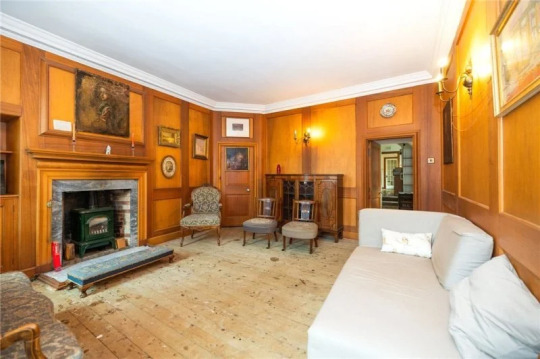
Seriously, for under $1M, it's like a small castle. Look at this sitting rooms paneled walls. It's a little dusty, and the floors need some refurbishing.

I don't know if any of the furnishings convey, but look at how bright it is, it's not a dreary old castle by any means.
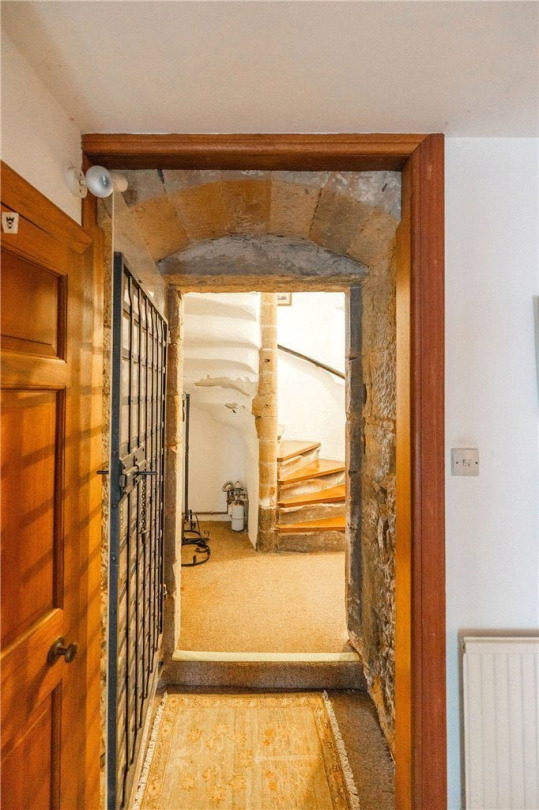
The original foyer is preserved. I would feel like royalty entering this residence.

This has to be one of the first-ever spiral staircases. Only the wood steps must've been added later. I love this.

The cabinetry is a little too modern, but it has an Aga stove, in blue (love the colors they come in) and the flooring matches.

The kitchen is definitely spacious. I wish that you could paint the cabinets and change out the hardware, but you can't do that with these- they're laminate and have built-in handles.

Hello, lover. This model costs over $32K.
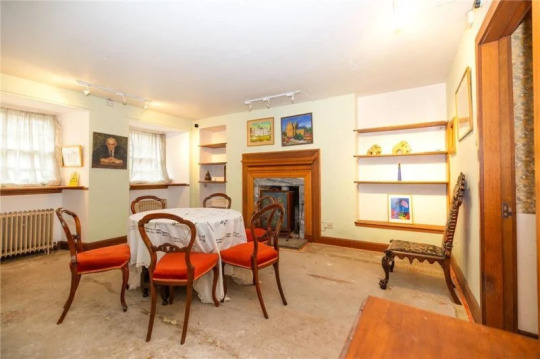
It looks like they may have stripped the carpeting off the floors. This is a nice big dining room with a fireplace and built-in shelving. I can't get over how much light this home gets.


Very nice. This room can be a library or an art studio. That looks like a built-in display case in the middle.

Closeup of one of the beautiful fireplaces. I would like to darken the wood a bit, and take out the orange tinge, but that would cost a fortune.

I would say that this is a bedroom. Everything looks freshly painted white, so it's a blank slate. Nice built-in cabinet along the wall.

Nice bedroom, it has a nook.

Cute little room for a study or home office.

This bath needs some attention.

A bedroom in the process of being packed up.

Ooh, I see a potential craft space in here.

Love the red sink in this nice big powder room.
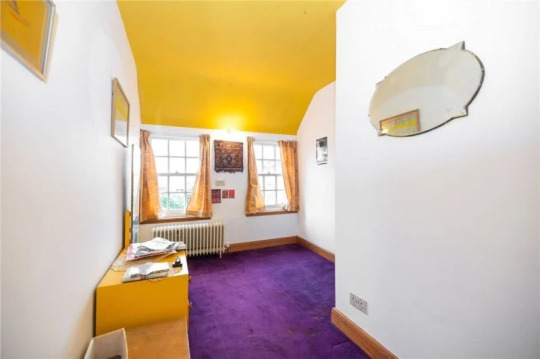
Here's a cool room. The colors of royalty.

The rooms on this floor are a bit small, but cozy.

Someone really liked red baths. The plumbing fixtures look pretty new, though.
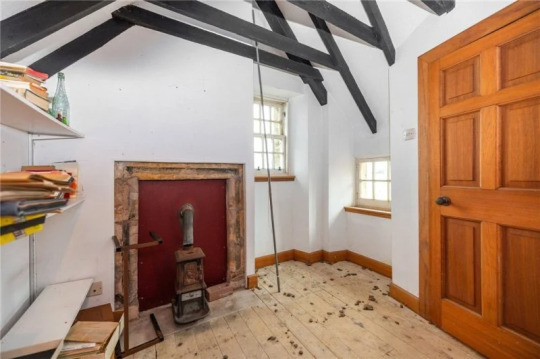
What an interesting room. Look at the beams and the old stove in the fireplace.

The courtyard and gardens have become overgrown and need some cutting back, but they will be beautiful.
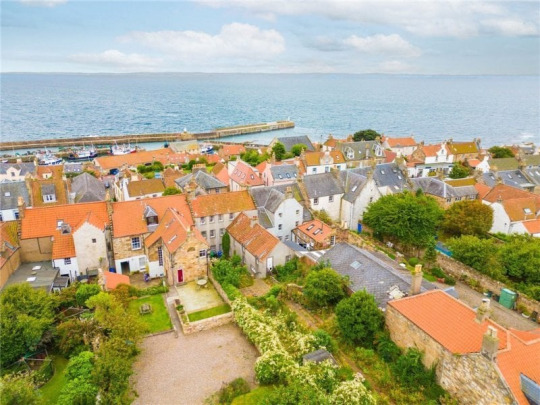
There are sea views from the upper floors. A private road provides access to off-street parking, also.
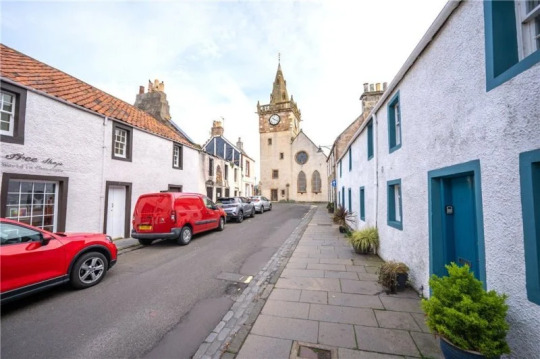
The home is located in the renowned East Neuk arts festival village, and for chocolate lovers, the town has its own chocolate factory.
#mini castle scotland#earl's summer residence for sale scotland#historic homes scotland#old house dreams#houses#house tours#home tour#submissions
147 notes
·
View notes
Text
Remember, remember.
@hp-12monthsofmagic
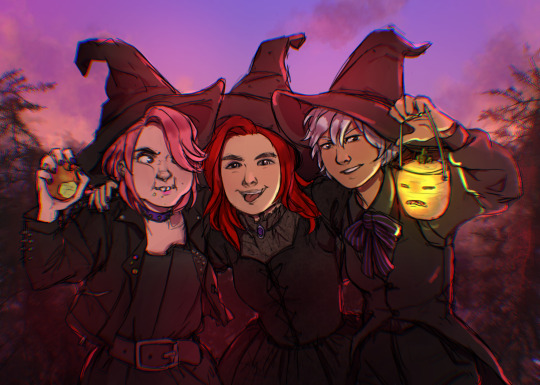
Traditionally, the magical community doesn’t observe Bonfire Night.
In the late 16th century, King James VI instigated the North Berwick witch trials - the first major persecution of witchcraft in Scotland. On the night of Halloween 1590, King James VI and his bride, Anne of Denmark, were caught up in a storm on the voyage back to Scotland. This misfortune was blamed on witchcraft, which was the start of trials which would last two years.
So it was no surprise that when in 1605 the Gunpowder Plot failed to take out the King, it wasn’t particularly a cause of celebration for magic-users. Their memories and thoughts remained with those persecuted during the trials, tortured til they either confessed or died.
Halloween on the other hand, with roots in Samhain/Samhuinn, is considered the Witches New Year. It’s observed from October 31st to November 1st, and it’s Hogwarts’ biggest event.
People are encouraged to wear their “witchiest” clothes, complete with witches hat.
Bonfires are lit
Turnip lanterns are carved to ward off evil spirits
There’s games involving treacle scones and apples. Braver students can try some of Hagrid’s treacle scones.
Prof Trelawney volunteers to do readings for students, which are very popular amongst couples. Break-ups peak around this time of year.
Among the merriment and festivities, it’s also a time for remembrance of those lost. The time of year where the veil between the world of the living and the world of the dead is at its thinnest.
#hogwarts mystery#nymphadora tonks#tulip karasu#hphm mc#freyja young#remember remember when king james decided witches could control the weather and then published a book on magic that endorsed witch burning?#which shakespeare then used to guide his writing of witchcraft in macbeth?#hp12mom#hp-12monthsofmagic
97 notes
·
View notes
Text

Church-ship model decorated with greek mythological sea folk, late 16th or early 17th century, traditionally associated with James VI and his safe return to Scotland with Anne of Denmark in 1590
Whether the model was donated for this reason is not entirely clear, but the probability is quite high when you consider that he almost died in a storm which he attributed to witchcraft. However, the model itself was given as a votive to a church to thank God for a safe journey.
37 notes
·
View notes
Text
There have been attempts, at the time and more recently, to argue that the outcome [of the Armada campaign] was just due to luck, or weather, or more in the nature of a draw, since Spain rebuilt a substantial navy in the early 1590s. Those arguments are unconvincing. The campaign of summer 1588 was an outstanding English victory. It was hard fought, and by the end, the English were almost out of ammunition. However, Drake’s fireships were a brilliant tactical device and Gravelines must count as one of the greatest English naval actions. It is clear from the profusion of pamphlets across Europe that everyone accepted Spain had been resoundingly defeated. Philip II never again considered an invasion of England by combined sea and land forces: the best his rebuilt navy could do was to raid Cornwall. The outcome of 1588 was a European turning point. England’s successful resistance showed that Spain was not invincible, encouraging Protestants in the Netherlands and France to continue their struggle. The Dutch threw off Spanish rule and Henri of Navarre became king of France, bringing religious peace and economic recovery. The young James VI of Scotland, bound to England by the treaty of Berwick in 1586 but alienated by the execution of his mother Mary Queen of Scots in 1587, shrewdly seized the Armada moment to emphasize his claim as Elizabeth’s heir. He wrote at the height of the crisis of summer 1588, assuring her of his support “as your natural son and compatriot of your country”.
Pauline Croft
15 notes
·
View notes
Text
Melrose Abbey, Scottish Borders.

David I founded Scotland’s first Cistercian monastery in 1136. Being so close to the border, Melrose Abbey suffered at English hands during the Middle Ages. Melrose’s location put it on the front line of conflict with England during the later Middle Ages.
Melrose was attacked by Edward I (1300 and 1307) and Edward II (1322) required major repairs. Also Richard II’s attacked Melrose in 1385 led to a complete rebuilding of the abbey church.
The Abbey suffered from the Protestant Reformation in 1560. Afterwards, the existing monks were allowed to stay on: the last died in 1590.
In 1996 during excavations of the abbey ruins a urn was discovered and confirmed to hold the heart of Robert the Bruce. A circular marker on the east side of the Abbey indicates the supposed final resting place.
39 notes
·
View notes
Text


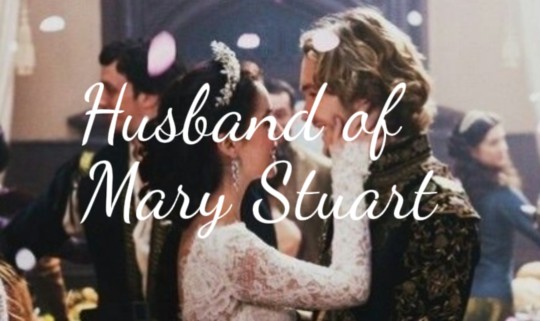



A happier life for Henry VIII's children: Part 3.
Edward was the son of King Henry VIII of England and his third wife Jane Seymour. The birth of a healthy boy was a great miracle and joy not only for his father, but for the whole of England. Edward's childhood was happy, because he had his own mother with him, who with her gentle voice could calm and support him. But it did not last long, in 1547 the boy had to grow up sharply and take on his children's shoulders the responsibility for the whole country, because his father Henry VIII died. His older sister Mary, Queen of France, became regent until the little king came of age. Mary ruled in her brother's place for 8 years. In addition, Mary and Jane did not allow the latter's brothers to influence the young king. Edward and Thomas Seymour were angry about this and they even tried to remove Mary from power, but they failed. The Queen of France uncovered the plot and sent them both to the Tower for life. In 1557 Mary's regency ended and she returned to France, and Edward became the rightful ruler of his state. Two years earlier the king had become interested in Protestantism, and secretly from his mother and sister he began to study it. At a council, he told his lords that he wished all England to convert to this religion, and most of his advisors supported his idea. The Queen Dowager of England tried several times to dissuade her son, but he became angry and made it clear that he would not allow her to interfere in his affairs of state. Queen Mary of France also did not lag behind and tried to return her brother to Catholicism and her attempts were not successful. But there were also those who disagreed, and because of this there were riots and rebellions in the country, the rioters demanded that the king left his venture and returned to the true faith. However, the king was not deterred by their demands, Edward managed to quell the rebellions and to appease his subjects, he declared in public that he would be tolerant and let them believe what they wanted. And to reconcile Catholics and Protestants, Edward promised to marry a Catholic princess, but their children would be Protestants, and to marry his other older sister Elizabeth to a Protestant. In 1558, the princess married the eldest son of the King of Sweden and left England for good. The king himself married Mary Stuart a year later. The marriage between the King of England and the Scottish Queen was a very successful and cohesive one. Mary appointed her consort as her companion and they lived on two countries.
Jane of England(1560 - 1618). Duchess of Angoulême. In 1578 she married her cousin Charles. Their married life was not a happy one. After the birth of their last child, the couple finally drifted apart and stopped living together. Four children were born in the marriage.
Henry IX of England(1561 - 1611). King of England, Ireland and Scotland. In 1589 he became King of England, and in 1600 of Scotland. In 1605 he proclaimed himself king of Great Britain. He was married, but did not love his wife, during their marriage he never touched her. Also the king had a mistress who bore him 5 children out of wedlock: Mary, Edward, Elizabeth, Grace and James. Died at the age of 51 of bubonic plague.
James I of England(1563 - 1627). King of Great Britain. Inherited from his older brother, as the latter had no legitimate children. Also, unlike Henry, he loved his wife and never cheated on her. Husband of Elizabeth of Denmark, father of 11 children: Edward VII, Sophia, Charles, George, Isabella, Joan, Frederick, Barbara, Henrietta, Arabella and Robert.
Mary of England(1564 - 1590). Mary was given in marriage to her cousin at the age of 18. The marriage produced 4 children. In 1590, Mary contracted pneumonia and died on the anniversary of her father's death.
Elizabeth of England(1567 - 1570). In 1570, the princess caught cold, contracted pneumonia and died at the age of 3.
Margaret of England(1569 - 1624). She was married twice, but both her husbands died shortly after the marriage. After the death of her second husband, Margaret declared that she would never marry again. She founded a charitable foundation and helped anyone in need, she especially focused on helping women and children.
Edward of England(1572 - 1586). Duke of Somerset and Albany. From birth had poor health. Died at the age of 14 from smallpox.
Richard of England(1575 - 1655). Duke of Somerset and Albany. After the death of his brother in 1586 all his titles passed to him. The Prince was noted for his good health and poetic ability. During his lifetime he became a famous poet. In 1600 he married Elizabeth Howard, after the wedding Richard and Elizabeth removed from the court and began to live a happy and quiet family life. The marriage produced 7 children: Mary, William, Edward, Philip, Anne, Catherine, and Nicholas.
Jane Seymour loved her daughter-in-law as her own daughter, the dowager queen liked to spend time in the circle of her grandchildren. On her son, she had almost no influence, but the king loved his mother and because of respect sometimes listened to her advice. Jane died in 1565, and Edward was greatly grieved by her death. Mary, more than anyone else, understood how her brother felt and despite their differences on matters of religion, came to England to give him moral support. In the end, they finally reconciled. Edward VI was a king beloved by the nobility and the people. For most of his reign, he tried to try on Catholics and Protestants and prevent religious warfare within the country. On top of that, the king gave shelter and protection to Protestants who had fled religious persecution. Edward VI died of tuberculosis in 1589. He was buried in Westminster Abbey next to his parents and other family members. Eleven years later, his wife Mary Stuart was buried next to him.
#english history#history#royal family#royalty#history au#au#royal#henryviii#the tudors#16th century#british royal family#edwardvi#marytudor#mary stuart#anne boleyn#catherine of aragon#elizabethi#elizabeth tudor#jane seymour
14 notes
·
View notes
Text

Coxton Tower; a late sixteenth-century tower house in Moray, Scotland. Heavily fortified, it was built around 1590.
18 notes
·
View notes
Text

SOUTH OF FRANCE:
When in France (525 words) by Dont-call-me-Sir
When in France (acrylic painting) by ripfredweasley
Nice Days (collage and ficlet) by academia4me
The French Riviera (7825 words) by angryessays
We're Taking this to Cannes (2321 words) by Orchidae
USA:
one way to tackle life (1258 words) by Orszula
Summer Heat (collage and ficlet) by academia4me
Yorktown (5226 words) by angryessays
Free weekend in New York (moodboard) by elpislady
Slight Miscalculation (3609 words) by Ariel_Tempest
SWITZERLAND:
The Alps are calling (780 words) by Dont-call-me-Sir
Dexmas goes Switzerland (collage) by ripfredweasley
SCOTLAND:
Highland Fling (collage and ficlet) by academia4me
Duneagle (5630 words) by angryessays
ENGLAND:
A Season's Fame (2000 words) by PoppaeaSabina
EGYPT:
stirs your spirit and your body (2410 words) by PoppaeaSabina
stirs your spirit and your body (collage) by academia4me
ITALY:
Bella Italia (400 words) by Dont-call-me-Sir
Lake Como (collage) by elpislady
CYPRUS:
Body to Body, Soul to Soul (1590 words) by angryessays
OTHER:
Hollywood Husbands visit 1980s (playlist) by elpislady
Hollywood Husbands visit 1980s (collage) by elpislady
Souvenirs (collage) by Orsuliya
Which means that as of today the map of Dexmas travels looks something like this:
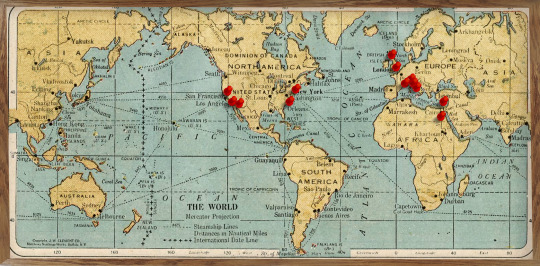
We'd like to extend special thanks, in no particular order, to: @angryessays, @ripfredweasley, @academia4me, @elpislady, @bitletsanddrabbles, @poppaeasabina, @o-rchidae and @orsuliya as well as all our dear co-travellers. See you next year!
22 notes
·
View notes
Text

St Mary's Abbey, Melrose is a partly ruined monastery of the Cistercian order in Melrose, Roxburghshire, in the Scottish Borders. It was founded in 1136 by Cistercian monks at the request of King David I of Scotland and was the chief house of that order in the country until the Reformation. It was headed by the abbot or commendator of Melrose. Today the abbey is maintained by Historic Environment Scotland as a scheduled monument.
The east end of the abbey was completed in 1146. Other buildings in the complex were added over the next 50 years. The abbey was built in the Gothic manner and in the form of a St. John's Cross. A considerable portion of the abbey is now in ruins. A structure dating from 1590 is maintained as a museum open to the public.
Alexander II and other Scottish kings and nobles are buried at the abbey. A lead container believed to hold the embalmed heart of Robert the Bruce was found in 1921 below the Chapter House site; it was found again in a 1998 excavation and documented in records of his death. The rest of his body is buried in Dunfermline Abbey.
The abbey is known for its many carved decorative details, including likenesses of saints, dragons, gargoyles and plants. On one of the abbey's stairways is an inscription by John Morow, a master mason, which says, Be halde to ye hende ("Keep in mind, the end, your salvation"). This has become the motto of the town of Melrose.
2 notes
·
View notes
Text



Robert Gordon of Straloch was born at Kinnundy in Aberdeenshire, on the 14th September, 1580 and is said to have been the first graduate of Marischal College.
I don't think these early cartographers get the credit they deserve, it's all too easy nowadays with sattelites and drones, but the cartographers of days gone by, in my opinion were every very talented people.
Robert was the younger son of Sir John Gordon of Pitlurg. After leaving Marischal College, he enrolled at the University of Paris. In 1608 Gordon married Catherine, daughter of Alexander Irvine of Lenturk, and they had nine sons and six daughters together.
Also in 1608 Gordon purchased the estate of Straloch, north of Aberdeen, and in 1619 he inherited the family estate of Pitlurg when his older brother John died without leaving children. The estates gave him the income he needed to pursue his academic interests, and over the following decades he became an eminent cartographer. He also published writings on a range of subjects including the ancient history of Scotland and the Gordon family history.
Such was Gordon's reputation that in 1641, Charles I wrote to him, asking him to carry forward the work undertaken by Timothy Pont in the 1580s and 1590s to map Scotland, verifying and, where necessary, revising his work. Gordon applied himself with enthusiasm, and the work was seen as so important that the Scottish Parliament exempted his son James Gordon from military service so he could assist, and the Church of Scotland wrote to all its clergy asking them to give Gordon every assistance in his task.
The work was completed in 1648 and subsequently published by the Blaeus of Amsterdam, under the title of Theatrum Scotiae. The second edition was published in 1655 and the third in 1662 and even by modern standards the cartography was impressive. Robert Gordon of Straloch died in 1661, being described in an obituary as "One of the most worthy and learned Gentlemen of our Nation". A grandson, also called Robert Gordon, founded the forerunner of Robert Gordon University in Aberdeen.
8 notes
·
View notes
Text
instagram
Episode 82: The Curse of The Scottish Play Photodump
Image 01: According to the lore, Shakespeare used a real witch’s dark magic spell as dialogue in his 1606 tragedy, Macbeth. This misuse of sacred incantation upset a coven of witches who cursed the play forevermore. The Three Witches painting by Macbeth by Alexandre-Marie Collin. Image 02: Around the time of Macbeth’s debut, the North Berwick Witch Trials were in effect. During the trials, over 70 people confessed to witchcraft while under extreme torture (which often resulted in death). This pamphlet from 1590 entitled “Newes of Scotland” depicts the coven meeting in a cemetery. Image 03: Records from the North Berwick Witch Trials maintain that the accused witches held their covens on the cemetery of Aulld Kirk Green, part of the modern-day North Berwick Harbour area, Scotland. Image 04-05: The Globe Theatre where Shakespeare’s Macbeth debuted was built in 1599 during the height of witch hunting mania. Image 06: Orson Welles’ all black cast of “Voodoo Macbeth” opened April 14, 1936 in Harlem, NYC. Welles changed the setting of his Macbeth to 19th century Haiti and featured real voodoo practitioners. Image 07: Welles’ Voodoo Macbeth was a hit, launching his directing career at only 21 years old. This is easily my favorite part. Comment “what is thy name” or “my name’s Macbeth” if you agree. Image 08: According to the legend, after a bad review of the show was written, a member of The Voodoo Macbeth cast offered to "make beri-beri (heart failure) on this bad man.” Within a week the critic had dropped dead. Image 09: Sir Patrick Stewart speaks about the superstitions surrounding Macbeth and he legally cannot tell a lie. SHOUT OUT TO @mikeyblaster for making the spooky music for this episode!
3 notes
·
View notes